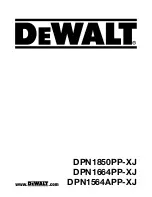
3-1/2", 28° Framing Nailer
5
For technical questions call: 1-800-665-8685
8314106
V 2.0
3. Maintain tools with care. Keep tools clean and in good condition for a better and safer performance. Follow
instructions for lubricating and changing accessories. Inspect tool fittings, alignment and hoses periodically
and, if damaged, have them repaired by an authorized technician or replaced. The handles must be kept
clean, dry and free from oil and grease at all times. A properly maintained tool reduces the risk of binding
and is easier to control. Applying excessive force can lead to slips and damage to your work or
personal injury.
4. Remove adjusting keys and wrenches. Check that keys and adjusting wrenches are removed from the tool or
machine before connecting it. A wrench or key that is left attached to a rotating part of the tool increases the
risk of personal injury.
5. Avoid unintentional starts. Be sure that the switch is in neutral or OFF position when not in use and before
connecting it to any air source. Do not carry the tool with fingers near or on the switch.
6. Only use the lubricants supplied with the tool or specified by the manufacturer. Other lubricants may not be
suitable and may damage the tool or even make the tool explode.
7. When not in use for an extended period, apply a thin coat of lubricant to the steel parts to avoid rust.
8. Maintain the label and name plate on the tool. These carry important information. If unreadable or missing,
contact Princess Auto for a replacement.
AIR SOURCE
1. Disconnect air supply. Disconnect tools from air pressure source when not in use, before cleaning, servicing
or changing a piece or accessory. After disconnecting, discharge any residual air pressure.
2. Do not use tools if the trigger switch does not function properly. Any tool that cannot be controlled with the
ON/OFF switch is dangerous and must be repaired.
3. Use proper size and type of air pressure line and fittings. The recommended air line for a tool with a 1/4”
inlet is 3/8” I.D.
4. Always verify prior to using a tool that the air source has been adjusted to the rated air pressure or within the
rated air-pressure range. Over pressurizing a tool may cause bursting, abnormal operation, breakage of the
tool or serious injury to persons. Use only clean, dry, regulated compressed air at the rated range as marked
on the tool.
5. Never use pure oxygen, carbon dioxide, combustible gases or any bottled gas as an air source for a tool.
Such gases are capable of causing an explosion and serious injury to persons. Do not use an air source
besides an air compressor to power this tool.
6. Always use an air regulator, an in-line filter and a moisture trap in your compressed air system. These
accessories will increase the tool’s life and keeps the tool in good working condition. See the diagram above
for recommended components of an airline.
7. Drain the air tank daily. Water in the airline will damage the tool.
8. Clean air inlet filter weekly.
9. Avoid using too long of an air hose. The longer the hose, the lower the pressure will be at the end of the
hose, to the point that it may not meet the minimum required for the tool. As well, a longer hose can
become a tripping hazard.
10. Keep hose away from heat, oil and sharp edges. Check hose for wear, and make certain that all connections
are secure.
11. Always carry a tool by its handle; never carry the tool by the air hose.
12. Line pressure should be increased to compensate for unusually long air hoses (over 26 ft.). The hose
diameter should be 3/8” l.D.
13. Air tool CFM consumption ratings are based upon a 25% duty cycle. If you require continuous duty, a
larger compressor will be required (e.g. 4.0 CFM tool at continuous duty requires 16.0 CFM to function at
maximum torque).
Summary of Contents for 8314106
Page 2: ......
Page 15: ...3 1 2 28 Framing Nailer 15 For technical questions call 1 800 665 8685 8314106 V 2 0...
Page 16: ......
Page 18: ......






































